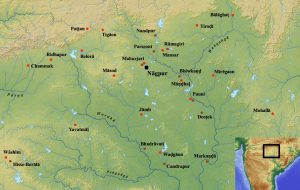
Ancient Vidarbha showing find-spots of Vākāṭaka inscriptions. (Zenodo).
| Metadata | |
|---|---|
| Object ID | OB00156 |
| Title | Wadgaon Plates of Pravarasena II |
| Subtitle | |
| Inscription(s) | IN00169 |
| Child Object | |
| Parent Object | |
| Related Objects | OB00156a OB00156b OB00156c OB00156d OB00156e |
| Responsibility | |
| Author | |
| Metadata recorded by | Dániel Balogh |
| Authority for metadata | |
| Metadata improved by | Dániel Balogh |
| Authoriy for improved | |
| Description | |
| Material | Metal / copper alloy |
| Object Type | Plate |
| Dimensions: | |
| Width | 16.5 |
| Height | 8.9 |
| Depth | |
| Weight | 1166 |
| Details | A set of four plates, the first and last inscribed only on the inner side, the others on both faces. The hole (1 cm in diameter) for the connecting ring is on the left-hand side, vertically at the centre, and horizontally 3.3 cm from the edge. The plates were linked by a ring, but their seal is lost. The second plate is thicker than the others and the second and third have thickened edges. |
| History | |
| Created: | |
| Date | |
| Place | |
| Other ancient history | |
| Found: | |
| Date | |
| Place | |
| Other modern history | |
| Latest: | |
| Date | 1963 |
| Place | Chhatrapati Shivaji Museum |
| Authority | Mirashi, Vasudev Vishnu. (1963). Inscriptions of the Vākāṭakas (Corpus Inscriptionum Indicarum 5). Ootacamund: Archaeological Survey of India. |
| Details | Discovered for scholarship in 1942, in the possession of a villager in Waḍgaon whose grandson saw another set of Vākāṭaka plates in Nagpur museum and brought these in for decipherment. Waḍgaon is in the Warorā tehsil of Cāndā district, Maharashtra, probably at 20.593436, 78.962857. There are at least two more settlements of the same name in the vicinity, but this one seems to be an independent hamlet, while the other two are presently districts or suburbs of larger towns (Chandrapur and Yavatmal). Chakravarti 1946: 49 says the plates were probably discovered at the village of Cicolī, but he also says the grandson was living in Cicolī in Wardha district in the 1940s, had lived in Waḍgāon earlier, and the plates had been in his family "for some generations," so his information seems conflicting; furthermore, there seems to be no village named Chicholi in the area. Mirashi identifies several toponyms mentioned in the charter in the immediate vicinity of modern Ciñcmaṇḍal (20.249763, 78.812875), which may be the same as Chakravarti's Cicolī. Mirashi recorded in 1963 that the plates were in the Prince of Wales Museum, Bombay (now Chhatrapati Shivaji Museum, Mumbai). |
| Notes | |